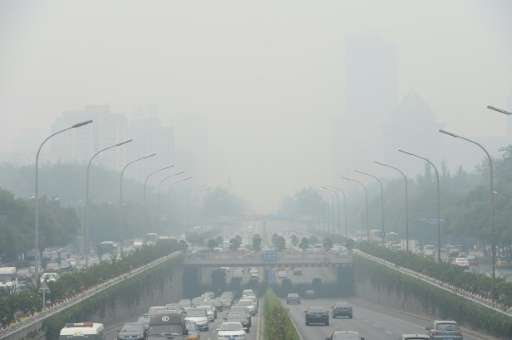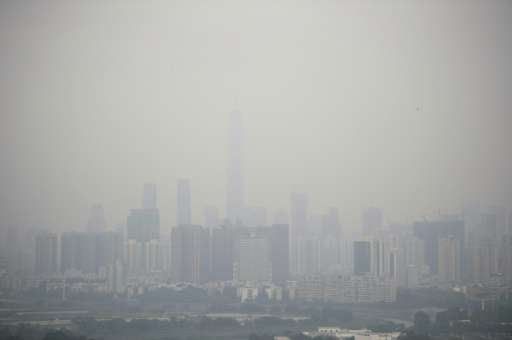Chinese cities, such as Beijing, pictured in June, are often hit by heavy pollution, blamed on coal-burning by power stations and industry, as well as vehicle use and climatic factors This picture taken on June 23, 2015 shows vehicles running in smog covered streets in Beijing. China's cities are often hit by heavy pollution, blamed on coal-burning by power stations and industry, as well as vehicle use. The issue has become a major source of popular discontent with the Communist Party, leading the government to vow to reduce the proportion of energy derived from fossil fuels.
Air pollution levels in China's cities improved in the first six months of this year, environmental campaign group Greenpeace said Wednesday, but remained far worse than global and domestic standards.
Average levels of PM2.5—airborne particulates small enough to deeply penetrate the lungs—declined 16 percent in 189 cities that were ranked both this year and last, Greenpeace said in a press release.
Only 18 cities showed increases, it added, on the basis of local government air quality readings it compiled.
In Beijing, PM2.5 levels fell 15.5 percent in January-June from the same period a year earlier, it said—but they still averaged 77.8 micrograms per cubic metre. The World Health Organization's recommended maximum annual average is 10.
Chinese cities are often hit by heavy pollution, blamed on coal-burning by power stations and industry, as well as vehicle use and climatic factors.
The issue has become a major source of popular discontent, leading the government to vow to reduce the proportion of energy derived from fossil fuels.
Premier Li Keqiang, who last year declared "war" on pollution, said in March that the country was falling short of people's expectations after a popular documentary drew attention to dismal air pollution levels.
Levels of sulphur dioxide (SO2)—mainly caused by the burning of coal and which Greenpeace described as a key factor behind secondary PM2.5 pollution—declined 42.6 percent in Beijing, Greenpeace said.
Premier Li Keqiang last year declared "war" on pollution, with major cities such as Shenzhen frequently suffering poor air quality
SO2 levels nationwide fell an average 18 percent during the period.
Despite the improvements, Greenpeace said that PM2.5 levels for the 358 cities surveyed were still more than five times World Health Organization's guidelines on average.
More than 80 percent of them had average levels above China's own standards, which are less strict.
Greenpeace attributed the falls to stricter implementation of penalties for pollution as well as caps on emissions.
"The drop in concentrations of PM2.5 and SO2... coincides with the five percent fall in coal consumption seen in the chemical, power generation, metals and construction industries in the first half of 2015," the release said.
It reiterated its call for "a nationwide cap on coal consumption".
© 2015 AFP
























